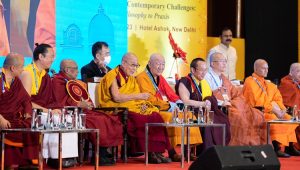The religious conference in New Delhi chose predominantly male faces to speak about “contemporary” Buddhism.

Credit: The Office of His Holiness the Dalai Lama (OHHDL) / Tenzin Choejor
The first Global Buddhist Summit, entitled “Responses to Contemporary Challenges,” was held from April 20-21, in India, where Shakyamuni Buddha lived and gave many teachings. One of the stated aims of the organizers, the International Buddhist Confederation, is “working to foster greater social and gender equality in accordance with Buddha’s teaching.” So it was disappointing to see very few female speakers represented.
Although there are many excellent and qualified female Buddhists, who are scholars, practitioners, and translators within their traditions, I was informed that only a handful of women were actual speakers at the event (around eight out of a total of 32), none of whom were on the main panels or spoke during the opening session.
For example, in the second day afternoon sessions, there were 10 male speakers and moderators, and only one female speaker, Jetsunma Tenzin Palmo, (who recently announced her retirement from in-person teaching). Tenzin Palmo, who is almost 80 years old, is a well-known writer, practitioner, and advocate of female empowerment and equality in Buddhism. Originally from Britain, she founded the nunnery Dongyu Gatsal Ling in India.
Ven. Bhikkhuni Lieu Phap Viditadhamma Theri, secretary and coordinator of the United Theravāda Bhikkhuni Sangha International and abbess of Sunnata Bhikkhuni Arama – Ni Vien Vien Khong, one of the leading Theravada Bhikkhuni nunneries in Vietnam, also spoke at the event, as did a few other women.
I was also myself a Summit invitee, with full support offered from the IBC, and am sorry I could not attend in person – I don’t know if this might have been so for other invited female Buddhist leaders invited as well. I appreciated the invitation and publicly apologized for not attending on my Facebook page two days ago straightaway when I saw the male line-ups, to try to help ameliorate the perception that not enough Buddhist women leaders were invited. Who we especially missed were the Buddhist women leaders from East Asia. The Chinese delegation was notably not able to join. And Buddhist leaders from several East Asian countries close to China also did not join. It’s a shame, because East Asia has some of the most powerful and excellent Buddhist women leaders of great eminence – sorry not to see them there. That’s politics.
Whatever the cause, judging by media coverage and photos, it looked like very few women were actively participating in the summit. The photos were predominantly of male speakers and delegates, which is not surprising because the vast majority of speakers were male.
Indian Prime Minister Narendra Modi gave an inspiring speech about Buddhism in India, and presented robes to a group of men, including Thich Tri Quang, the 43rd Sakya Trizin Rinpoche, and Drikung Chetsang Rinpoche. However, no woman was given robes. Other photos of the event revealed all-male dinners, with only monks and Rinpoches in attendance.
This lack of female speakers at the Global Buddhist Summit reminded me of the 4th Vajrayana conference in Bhutan last year, when there were also zero female speakers in the opening ceremony. When I politely asked the Bhutanese organizer (another man) why there were no female speakers, he did not answer and seemed rather put out by the question. That conference was entitled – rather ironically, in retrospect – “Modernity in Buddhism.”
In addition, my presentation, which was on the female, non-monastic roots of Vajrayana in India, was later not published. When I asked for a reason, I was either ignored or abruptly (and rudely) told that they intended to publish all of the presentations. However, it has still not been published to date. (For those who would like to see and hear what I presented in Bhutan, please see the video here; the summary and transcript is here.)
The phenomenon of all-male panels and conferences is nothing new, of course, nor is it unique to Buddhist events. There is a special term for such events – the “manel” – and even a comic website aimed at exposing them. Nonetheless, it is uninspiring and even hope-killing for women (and children) to see a religion dominated by men, where women are still not granted equal respect for their voices, experiences, talents, and bodies. But within religious and Buddhist circles, no one seems to have batted an eyelid at the glaring omission. Apparently gender equality is one contemporary challenge that seems to be unworthy of notice or discussion.
The Global Buddhist Summit could have been a great opportunity for Buddhists, from all cultures and walks of life, to show how important and valuable women are in helping respond to contemporary challenges within the Buddhist communities. Instead, it became one endless show of men in monastic robes. Where is the inspiration for female nuns and lay Buddhists in that?
A previous version of this article was published on the author’s website.
